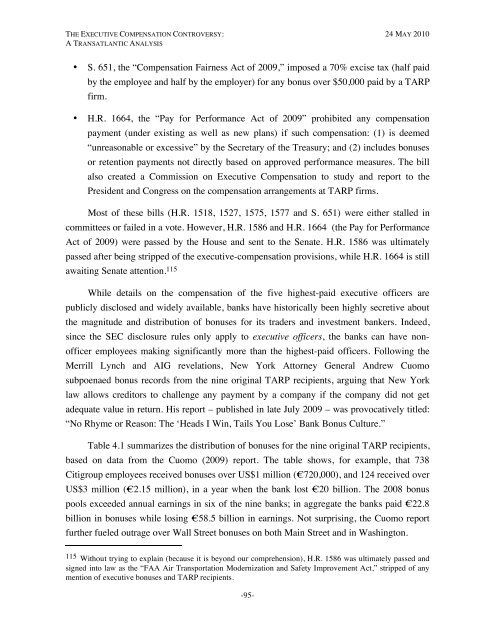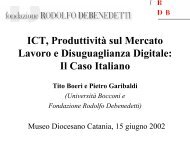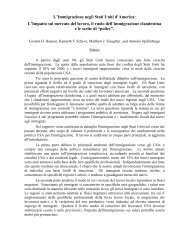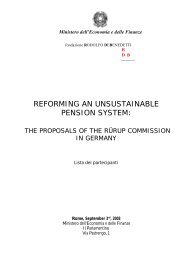The Executive Compensation Controversy - Fondazione Rodolfo ...
The Executive Compensation Controversy - Fondazione Rodolfo ...
The Executive Compensation Controversy - Fondazione Rodolfo ...
Create successful ePaper yourself
Turn your PDF publications into a flip-book with our unique Google optimized e-Paper software.
THE EXECUTIVE COMPENSATION CONTROVERSY: 24 MAY 2010A TRANSATLANTIC ANALYSIS• S. 651, the “<strong>Compensation</strong> Fairness Act of 2009,” imposed a 70% excise tax (half paidby the employee and half by the employer) for any bonus over $50,000 paid by a TARPfirm.• H.R. 1664, the “Pay for Performance Act of 2009” prohibited any compensationpayment (under existing as well as new plans) if such compensation: (1) is deemed“unreasonable or excessive” by the Secretary of the Treasury; and (2) includes bonusesor retention payments not directly based on approved performance measures. <strong>The</strong> billalso created a Commission on <strong>Executive</strong> <strong>Compensation</strong> to study and report to thePresident and Congress on the compensation arrangements at TARP firms.Most of these bills (H.R. 1518, 1527, 1575, 1577 and S. 651) were either stalled incommittees or failed in a vote. However, H.R. 1586 and H.R. 1664 (the Pay for PerformanceAct of 2009) were passed by the House and sent to the Senate. H.R. 1586 was ultimatelypassed after being stripped of the executive-compensation provisions, while H.R. 1664 is stillawaiting Senate attention. 115While details on the compensation of the five highest-paid executive officers arepublicly disclosed and widely available, banks have historically been highly secretive aboutthe magnitude and distribution of bonuses for its traders and investment bankers. Indeed,since the SEC disclosure rules only apply to executive officers, the banks can have nonofficeremployees making significantly more than the highest-paid officers. Following theMerrill Lynch and AIG revelations, New York Attorney General Andrew Cuomosubpoenaed bonus records from the nine original TARP recipients, arguing that New Yorklaw allows creditors to challenge any payment by a company if the company did not getadequate value in return. His report – published in late July 2009 – was provocatively titled:“No Rhyme or Reason: <strong>The</strong> ‘Heads I Win, Tails You Lose’ Bank Bonus Culture.”Table 4.1 summarizes the distribution of bonuses for the nine original TARP recipients,based on data from the Cuomo (2009) report. <strong>The</strong> table shows, for example, that 738Citigroup employees received bonuses over US$1 million (€720,000), and 124 received overUS$3 million (€2.15 million), in a year when the bank lost €20 billion. <strong>The</strong> 2008 bonuspools exceeded annual earnings in six of the nine banks; in aggregate the banks paid €22.8billion in bonuses while losing €58.5 billion in earnings. Not surprising, the Cuomo reportfurther fueled outrage over Wall Street bonuses on both Main Street and in Washington.115 Without trying to explain (because it is beyond our comprehension), H.R. 1586 was ultimately passed andsigned into law as the “FAA Air Transportation Modernization and Safety Improvement Act,” stripped of anymention of executive bonuses and TARP recipients.-95-









